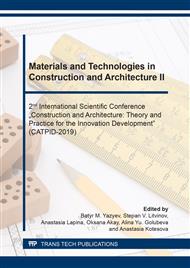[1]
V.F. Stepanova, A.Yu. Stepanov, E.P. Zhirkov, Composite polymer Reinforcement, Bumazhnik, Moscow, (2013).
Google Scholar
[2]
A.M. Umansky, T.A. Becker, The prospects for the use of composite reinforcement, FEFU, School of Engineering Bulletin. 2 (11) (2012) 7-13.
Google Scholar
[3]
H.A. Hejew, Y.V. Puharenko, Gypsum concrete composites reinforced with basalt fibers, Bulletin of Civil Engineers. 2 (37) (2013) 152-156.
Google Scholar
[4]
P.P. Polskoy, D.R. Mailyan, Composite materials – as the basis of performance in the construction and renovation of buildings and structures, Engineering journal of Don. 4-2 (2012) 162.
Google Scholar
[5]
V.I. Rimshin, S.I. Merkulov, About Normalization of Characteristics of Rod Non-Metallic Composite Reinforcement, Industrial and Civil Engineering. 5 (2016) 22-26.
Google Scholar
[6]
G.A. Gizdatullin, R.R. Khusainov, V.G. Khozin, N.M. Krasinikova, Strength and deformability of concrete structures reinforced with fibre-reinforced polymer bars, Magazine of Civil Engineering. 2 (2016) 32-41.
DOI: 10.5862/mce.62.4
Google Scholar
[7]
V.N. Nikolaev, V.F. Stepanova, The Use of Polymer Composite Rebar for Supports of the Contact-Line with Anchorage on Foundations, Industrial and Civil Engineering. 7 (2016) 79-84.
Google Scholar
[8]
A.V. Benin, S.S. Semenov, Experimental Study of Bond Behavior Between FRP Rebars with Flat Winding and Concrete, Industrial and Civil Engineering. 9 (2013) 74-76.
Google Scholar
[9]
V.I. Rimshin, Yu.O. Kustikova, Phenomenological researches of size of coupling basalt fiber armature with concrete, Proceedings of South-West State University. Series: Technics and Technologies. 1 (2011) 27-31.
Google Scholar
[10]
V.G. Khozin, A.A. Piskunov, A.R. Gizdatullin, A.N. Kuklin, Adhesion fiber-reinforced polymer bars with cement concrete, News of the Kazan State University of Architecture and Engineering. 1 (23) (2013) 214-220.
Google Scholar
[11]
O.Ya. Berg, Yu.M. Nagevich, Some features of the process of destruction of fiberglass reinforcement, Concrete and Reinforced Concrete. 9 (1965) 34-36.
Google Scholar
[12]
A.N. Blaznov, V.F. Savin, A.A. Krasnov, Prediction of strength of composite rods under the influence of alkaline medium, South Siberian Scientific Bulletin. 4 (8) (2014) 12-14.
Google Scholar
[13]
S.V. Fedosov, V.E. Rumayntseva, V.S. Konovalova, I.V. Karavaev, Liquid corrosion of concrete in the environment with various degree of aggressiveness, Bulletin of Civil Engineers. 4 (63) (2017) 113-118.
Google Scholar
[14]
V.E. Roumyantseva, I.V. Karavaev, V.S. Konovalova, S.A. Loginova, Corrosion of concrete with the water-repelling additives, Improving the efficiency of processes and devices in chemical and related industries: proceedings of the International scientific and technical conference dedicated to the 105th anniversary of the birth of A.N. Planovsky. 2 (2016) 138-141.
Google Scholar
[15]
V.E. Rumayntseva, V.S. Konovalova, I.V. Karavaev, S.A. Loginova, Influence of aggressive environments on the change of structural and phase composition of cement concrete and on their strenght characteristics, Information environment of the University. 1 (23) (2016) 372-376.
Google Scholar
[16]
V.E. Rumayntseva, V.S. Konovalova, I.V. Karavaev, S.A. Loginova, Change of strength characteristics of concrete with hydrophobizing additives in liquid corrosion of second type, Modern trends in science and technology. 4-3 (2016) 104-107.
Google Scholar
[17]
I.V. Karavaev, V.E. Rumayntseva, V.S. Konovalova, Influence of the type of anchoring on the adhesion of composite reinforcement to concrete, Physics of fibrous materials: structure, properties, science-intensive technologies and materials (SMARTEX-2017). 1 (2017) 115-117.
Google Scholar
[18]
V.E. Rumayntseva, I.V. Karavaev, The impacting by fiberglass reinforcement to fiberglass reinforced concrete, Information environment of the University. 1 (23) (2016) 106-109.
Google Scholar
[19]
I.V. Karavaev, V.E. Rumayntseva, V.I. Karavaev, Study of the effect of coating on the anchoring of composite reinforcement in concrete, Theoretical and applied aspects of modern science. 9-2 (2015) 84-87.
Google Scholar
[20]
I.V. Karavaev, V.E. Rumayntseva, V.S. Konovalova, To the question of adhesion strenght of composite reinforcement with concrete, Physics of fibrous materials: structure, properties, science-intensive technologies and materials (SMARTEX-2016). 1-2 (2016) 124-127.
Google Scholar


